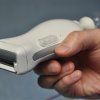Photoacoustic imaging can provide clinically relevant information about the molecular composition of objects just below a patient’s skin. This requires shining a laser at the target and then listening for returning sound waves that are created from the laser heating up nearby tissue. The limitation of using this technique in practice has been the bulky equipment that is hard to use and not practical for clinical applications.
Now a team of European researchers managed to modify a commercial ultrasound probe to perform photoacoustic imaging and conventional ultrasound at the same time. This was possible by developing a diode laser that’s more powerful than any laser of this type previously created. The small size of the laser allowed it to be embedded within the ultrasound probe, while its diode nature lets it be fired off repeatedly at a very high rate, providing real-time imaging at high resolution. Currently, the laser operates at a single wavelength in the near-infrared range. The researchers hope to expand that to include a wider range of frequencies that may be more appropriate for visually resolving different compounds.
source:optics infobase
Photoacoustic Imaging Technology Moves Closer to Clinical Practice

